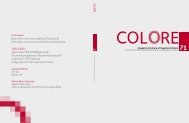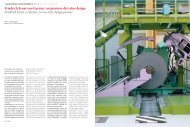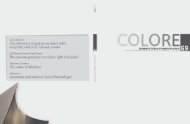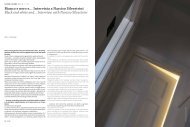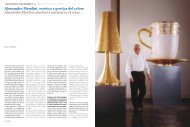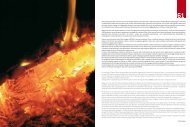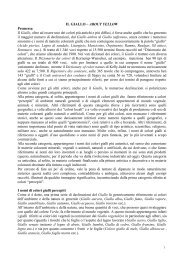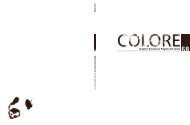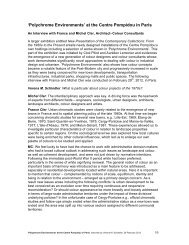Quaderni di Cultura e Progetto del Colore - Istituto Del Colore
Quaderni di Cultura e Progetto del Colore - Istituto Del Colore
Quaderni di Cultura e Progetto del Colore - Istituto Del Colore
Create successful ePaper yourself
Turn your PDF publications into a flip-book with our unique Google optimized e-Paper software.
INTERVISTA / INTERVIEW [ 1 2 3 4 (5 + 6) ]<br />
cere scoprire che la superficie curva e la forma vagamente simile alla<br />
figura <strong>del</strong> toro ottenuta allungando la tela lungo una struttura curvata<br />
enfatizzava questa apparente “dematerializzazione” <strong>del</strong>la superficie.<br />
Un’altra scoperta dai miei primi lavori, ma amplificata dal nuovo contesto<br />
<strong>del</strong> ciclorama, era l’effetto <strong>di</strong> apparente luminosità reso possibile da<br />
specifiche <strong>di</strong>sposizioni <strong>di</strong> forma e colore – dal momento che ero assai<br />
desideroso che il ciclorama emettesse un senso <strong>di</strong> luce propria.<br />
E così, sebbene avessi creato un <strong>di</strong>pinto a 360 gra<strong>di</strong>, il mio metodo <strong>di</strong><br />
presentazione ed i miei obbiettivi erano nettamente <strong>di</strong>versi da quelli dei<br />
tra<strong>di</strong>zionali panorama costruiti sulla prospettiva <strong>del</strong> <strong>di</strong>ciannovesimo<br />
secolo. A <strong>di</strong>fferenza <strong>di</strong> quei lavori, non volevo che una piattaforma centrale<br />
limitasse lo spettatore in quanto pensavo fosse cruciale ci fosse<br />
una pavimentazione ininterrotta che permettesse la piena libertà per<br />
lo spettatore <strong>di</strong> avere l’esperienza <strong>del</strong> <strong>di</strong>pinto secondo quanto la propria<br />
immaginazione potesse permettere. L’opera non aveva una illusoria<br />
funzione descrittiva; piuttosto, era pensata come uno stimolo per una<br />
esperienza reale – un’esperienza <strong>del</strong> momento proprio <strong>del</strong>la visione<br />
senza riferimenti al <strong>di</strong> fuori <strong>del</strong>l’opera stessa. Sebbene comprendevo<br />
bene che uno spettatore curioso potesse anche estrapolare più da un<br />
tra<strong>di</strong>zionale panorama <strong>di</strong>pinto in prospettiva rispetto ad uno spettatore<br />
passivo, ciò nonostante consideravo il primo formato come progettato<br />
per uno spettatore più passivo e capii che questa è la ragione per cui il<br />
formato è spesso citato come precursore <strong>del</strong> cinema. Il mio obiettivo,<br />
tuttavia, con Cyclorama 2000 è stato quello <strong>di</strong> creare una superficie <strong>di</strong>pinta<br />
a 360 gra<strong>di</strong> in cui uno spettatore attivo è coinvolto nella scoperta<br />
autonoma per comprendere alcune <strong>del</strong>le ambiguità circa il nostro senso<br />
<strong>di</strong> realtà ed il modo in cui costruiamo il nostro universo visivo.<br />
Nota <strong>del</strong>l’e<strong>di</strong>tore: Dal momento <strong>del</strong>la conferenza <strong>del</strong> 2004, l’artista(fig. 4) ha completato un<br />
altro progetto <strong>di</strong> ciclorama, E-Cyclorama, esposto presso l’ E<strong>di</strong>nburgh College of Art, E<strong>di</strong>nburgh,<br />
Scotland, 2008(fig. 5), ed il Neuberger Museum, Purchase, New York, 2009. Egli al momento<br />
sta lavorando ad un terzo ciclorama.<br />
moment of viewing with no reference outside the work itself. Though I<br />
well understood that a searching viewer might also glean more from a<br />
tra<strong>di</strong>tional perspective panorama painting than a passive viewer, I nevertheless<br />
understood the earlier form as having been designed for a<br />
more passive viewer and felt that this is why the form is often cited as a<br />
precursor of cinema. My goal, however, in Cyclorama 2000 has been to<br />
create a painted 360-degree surface to which an active viewer is drawn<br />
through self <strong>di</strong>scovery to realize some of the ambiguities of our sense<br />
of reality and the way we construct our visual world.<br />
E<strong>di</strong>tor’s note: Since the conference in 2004, the artist (fig 4) has completed another cyclorama<br />
project, E-Cyclorama, exhibited at the E<strong>di</strong>nburgh College of Art, E<strong>di</strong>nburgh, Scotland, 2008(fig<br />
5), and the Neuberger Museum, Purchase, New York, 2009. He is at work on a third cyclorama.<br />
fig.4<br />
Perchè un Ciclorama? / Why a Cyclorama?<br />
22 COLORE<br />
COLORE 23<br />
fig.5



